Transportation and getting around can be difficult if you lack experience or don’t understand Japanese. Thankfully, Japan has one of the best transportation infrastructure in the world. Here is a practical guide to help you make your travel in Japan smooth!
Today, we will be discussing trains, shinkansen, and subway.
Click here for buses, taxi, and rental cars!
- Tips for a smooth journey
- Important things to remember
- Being a polite traveler
- General Japanese vocabulary for the train and subway station
- Transportation using travel cards and passes *How to avoid the complicated ticket system!
- Available travel cards and passes
- Refilling and using your card
- Transportation using tickets
- Transportation by train
- Types of trains
- Travel by shinkansen (bullet train)
- Useful Japanese for travel by shinkansen
- Types of shinkansen
- Types of shinkansen tickets
- The base fare ticket and add-ons
- Ticket types
- Transportation by subway
- Useful Japanese in the subway station
- The many lines of the subway station
- Transportation by trains, shinkansen, and subway links!
- Top 3 travel cards
- Special opportunities for tourists and short-term stays
- Travel with Rakuten!
Tips for a smooth journey
Important things to remember
Keep your ticket or IC card with you at all times – If you buy a ticket and lose it, or lose your card, then you will have to repurchase the card and ticket before exiting the ticket gate… You will also have to explain to the attendant about which station you departed from, which can be difficult if you don’t know Japanese well.
Keep your passport or residence card with you at all times- Sometimes people who look foreign or like tourists will be checked for their ID. You may not be able to pick up your ticket without it.
Plan ahead and leave early- Japanese trains and transport are usually always right on time! But unplanned situations happen, and you don’t want to lose money by missing your train. Keep time for asking questions and getting around the station. The bigger stations have fun places to shop and eat to kill time.
Keep your eye on cancellations and delays- Japan is a country with a lot of natural disasters. Sometimes heavy rain or snow will cancel or delay a train for the entire day! Keep watch on the status of your transport.
Ask for help- Never be afraid to ask for help. Japanese people are really friendly and will even try their best to use your language to help you find a solution.
Being a polite traveler
Talking on the train- Many trains, subways, and especially shinkansen are super quiet. Some people may be trying to sleep before or after work. Some students may be studying. There are always exceptions, but it would be polite to be mindful of those around you. There are some situations where people talk on the train… If the locals and many people are doing it, then don’t feel bad about having a chat : )!
By the way, I have never seen someone using a phone on the train without angry stares. It is better to avoid talking on the phone when you are on the train.
Women-only cars– Some areas have cars only for women. If you are a man, you don’t want to make the mistake of getting on here and making everyone feel uncomfortable. It is usually marked at the boarding area and on the windows. Some have certain hours in which they function as normal cars, so please check!
Priority seats- These seats are usually a special color or marked with a sticker on the window. They are for people who have disabilities, or who have trouble standing for a long time. If you are healthy and capable, please avoid using it, or give up your seat when someone needs it. If you need it, never feel ashamed to use it.
Dining and Drinking- For most trains and transport in general, it is considered very rude to eat or drink on the train. (If you have a water bottle or some beverage that can be re-sealed, that is fine!) Some trains, like long-distance and shinkansen, are okay to eat and drink on. But always avoid smelly foods.
General Japanese vocabulary for the train and subway station
General vocabulary for the train and subway station:
- 駅 (eki) – Station
- 改札口 (kaisatsuguchi) – Ticket gate
- 切符売り場 (kippu uriba) – Ticket counter
- ホーム (hoomu) – Platform
- ホームドア (hoomu doa) – Platform screen doors
- 新幹線 (shinkansen) – Bullet train
- 在来線 (zairaisen) – Conventional train line
- 乗り場 (noriba) – Boarding area
- 列車 (ressha) – Train
- 到着 (touchaku) – Arrival
- 出発 (shuppatsu) – Departure
- 時刻表 (jikokuhyou) – Timetable
- 運賃表 (unchinhyou) – Fare table
- 遅延 (chien) – Delay
- 改札口を入る (kaisatsuguchi wo hairu) – Enter through the ticket gate
- 改札口を出る (kaisatsuguchi wo deru) – Exit through the ticket gate
- 乗り換え (norikae) – Transfer (between trains or lines)
- 自動券売機 (jidou kenbaiki) – Ticket vending machine
- 駅員 (ekiin) – Station attendant
- 案内 (annai) – Information (e.g., information desk)
Transportation using travel cards and passes *How to avoid the complicated ticket system!
Before you think about going the old-fashioned way and buying tickets to get around Japan, please consider getting a travel card or pass! These are much easier to use than tickets and you will have a wonderful keepsake from your travels after you leave Japan.
For long-term residents, travel passes that allow you to go between certain destinations without a limit and for a fixed price are available. They are usually paid for by workplaces to cover travel expenses. Ask your employer if you are qualified to get it covered! Otherwise, be ready to shell out a lot of cash. Make sure it’s worth it for you!
Finally, these work for both trains and subways. Shinkansen tickets are a bit different. Check the Shinkansen section for more information.
Available travel cards and passes
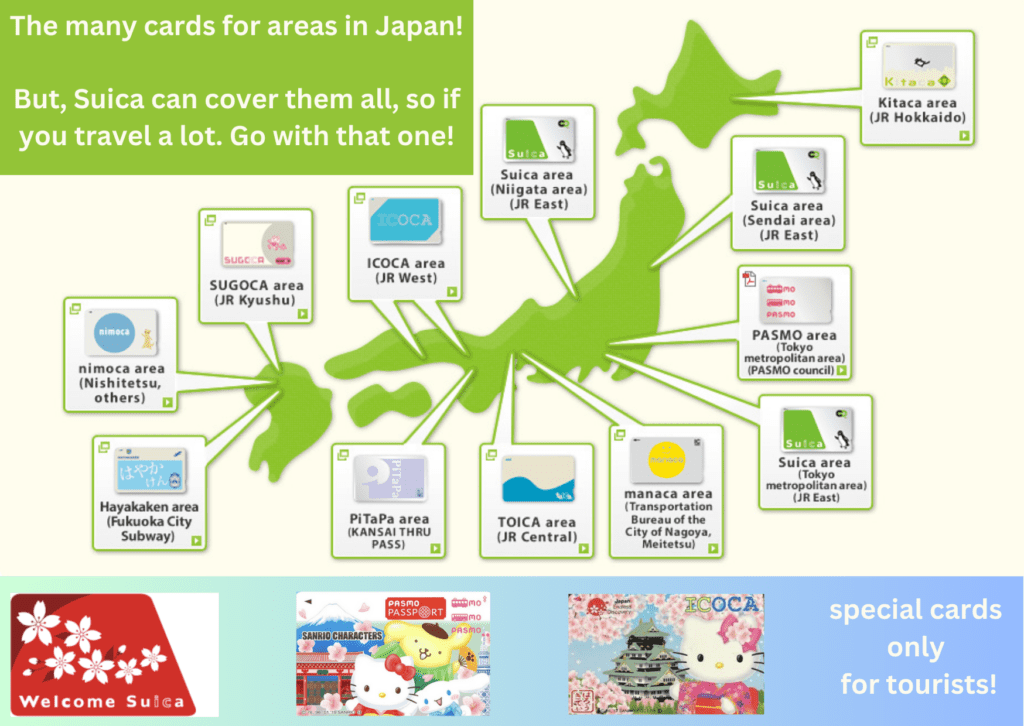
The big three, the most popular and most useful cards are:
- Suica
- Pasmo
- Icoca
You can get these cards at the station, usually from a ticket machine. If you have trouble, you should ask a station attendant or staff member. They would be very happy to help you get started with your own IC card.
Some cards have apps available for travel. The sign-up can be a bit confusing, but it might be worth it if you are staying in Japan for a while. The good point with the app is that you can charge your card at any time.
There are special design cards available for short-term visitors to Japan! They usually have cute designs and give steep discounts for traveling around. Keep in mind these are only available for short-term visitors.
Travel passes and ticket discounts are also available to short-term visitors! Check out the link here at JR West to see some of the available deals. Keep in mind these are only available for short-term visitors.
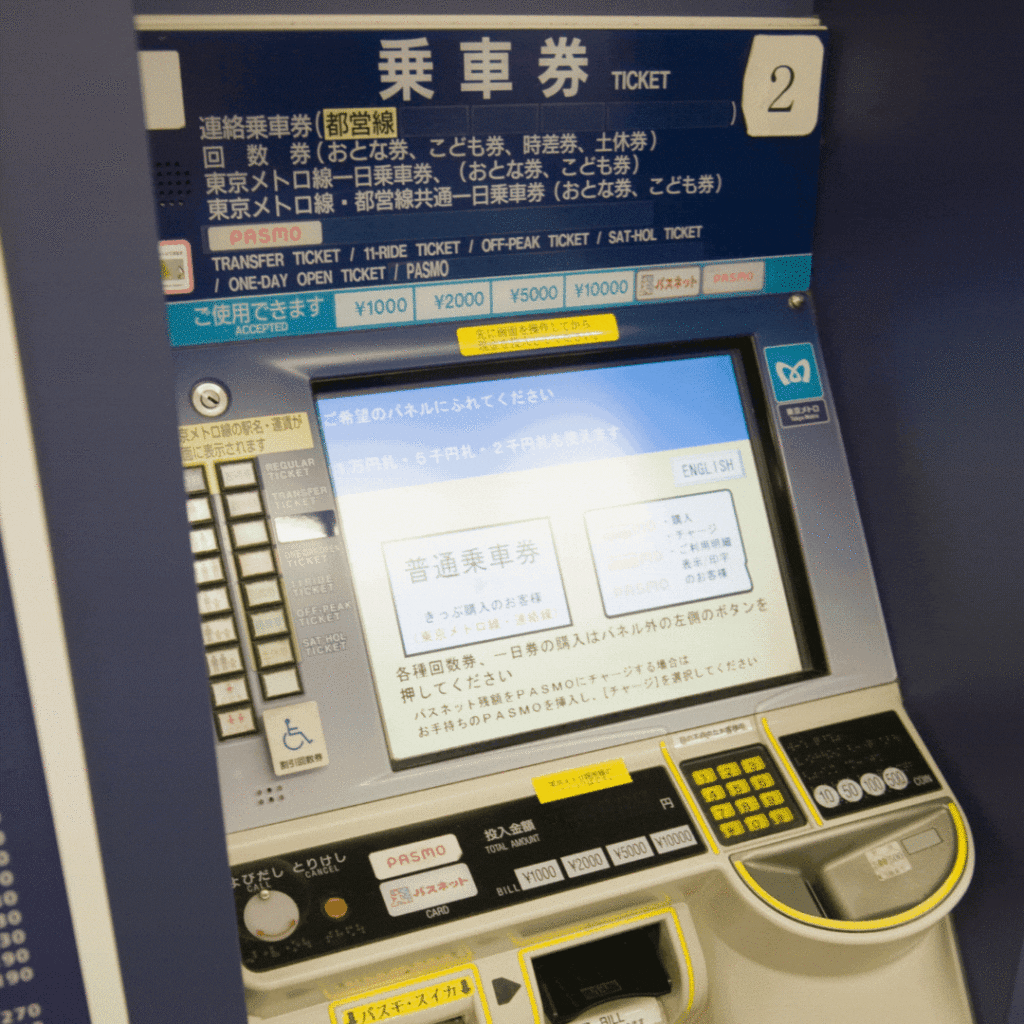
Refilling and using your card
When you have a card, you just charge the card at a ticket machine by placing the card on a charging pad (there is a picture indicating a card on it) or by inserting it into the card slot. Some cards are also rechargeable online or through an app. You can usually charge in increments of 1000 yen.
Then, it is as simple as tapping the card on the card reader when you enter and exit the ticket gate!
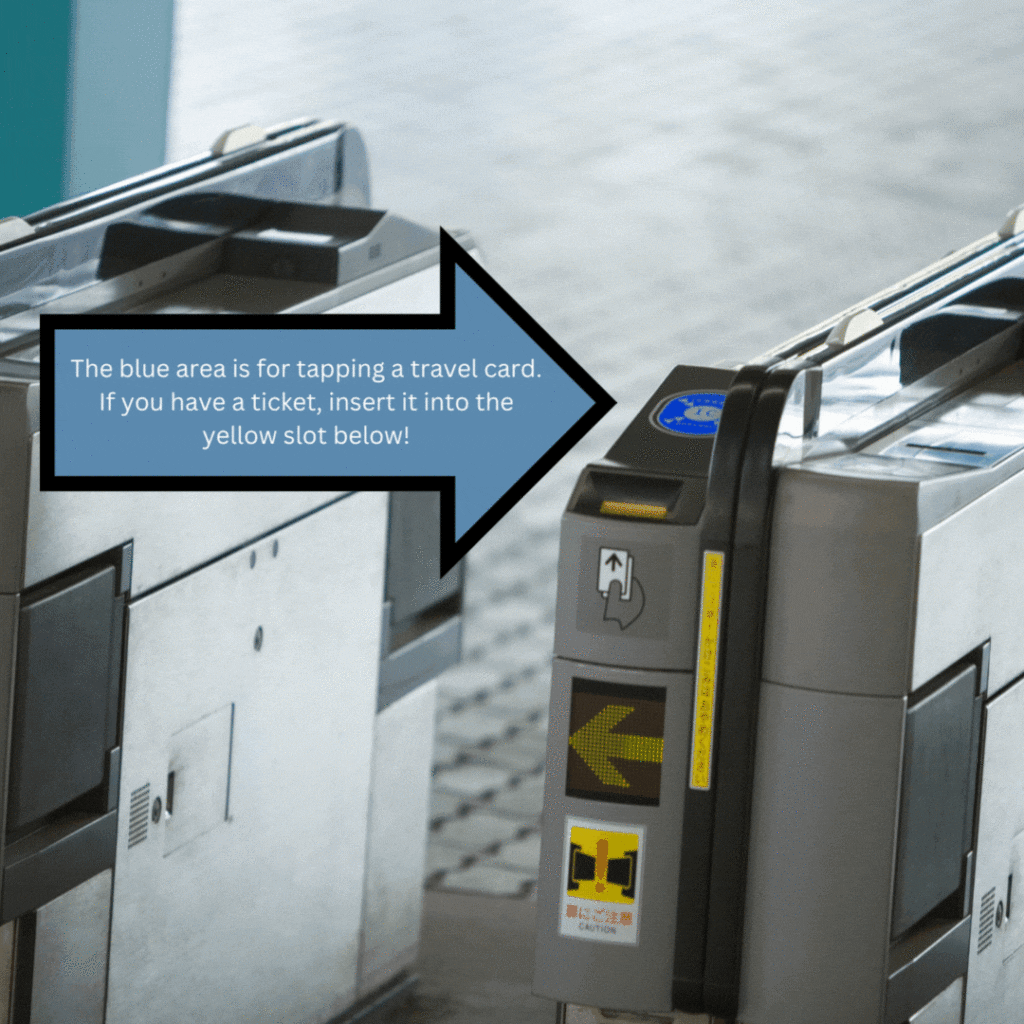
Transportation using tickets
Buying tickets can be a bit confusing, but the process is not so difficult once you get used to it! There are often attendants available to help you if you are having trouble. Press the big red button on the ticket machine if you need one!
Just so you know, this is a typical map of the trains in Japan… It can be overwhelming and sometimes there is no English. Don’t be afraid to ask for help!
Finally, these work for both trains and subways. Shinkansen tickets are a bit different. Check the Shinkansen section for more information.
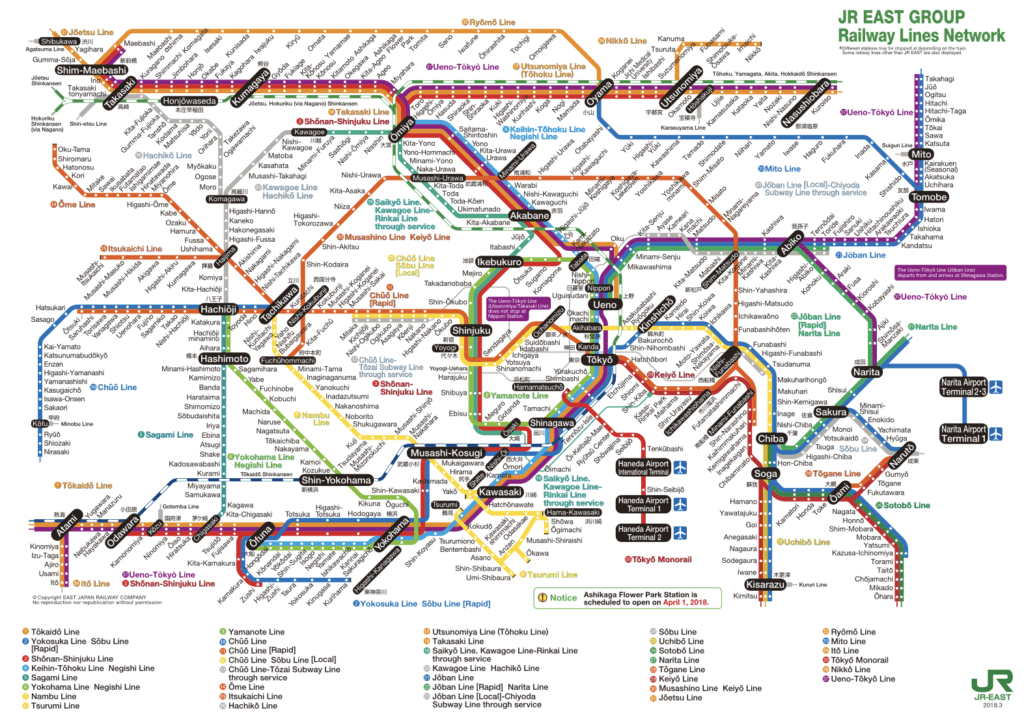
Here is a simple step-by-step guide to buying tickets:
- Find the Ticket Machine: Look for a ticket vending machine near the entrance or ticket gate of the train station.
- Select Language: Most machines have an English option. If not, look for a button that says “English” (in Japanese it’s 英語).
- Choose Destination: Use the touchscreen or buttons to select your destination. Stations are listed by name and sometimes by number (e.g., “Tokyo” or “東京”). You should buy the ticket that is the price of your destination. You can ask for help or check Google Maps (which often shows ticket prices in the travel instructions) if you are unsure of the ticket price.
- Select Ticket Type: Choose the type of ticket you need (e.g., one-way, round-trip).
- Insert Money: Insert cash or a credit card (some machines accept international cards). If you use cash, please know that smaller yen units may not be accepted (For example, 1 yen)
- Receive Ticket: The machine will dispense your ticket and any change.
- Exit Ticket Gate: Insert your ticket into the ticket gate to enter the platform area. Keep your ticket until you reach your destination, as you will need it to exit the station.
Transportation by train

Useful Japanese for travel by train:
- Ticket Purchase (If you have trouble using the machine, ask an attendant for help like this):
- English: “Excuse me, one ticket to [destination], please.”
- Japanese: すみません、[目的地] までの切符を一枚お願いします。 (Sumimasen, [mokuteki] made no kippu wo ichimai onegaishimasu.)
- Asking for Information:
- English: “Excuse me, which platform is the train to [destination]?”
- Japanese: すみません、[目的地] 行きのホームはどこですか? (Sumimasen, [mokuteki] yuki no hoomu wa doko desu ka?)
- Boarding the Train:
- English: “Excuse me, is this seat taken?”
- Japanese: すみません、この席は空いていますか? (Sumimasen, kono seki wa aiteimasu ka?)
- During the Journey:
- English: “Excuse me, how many stops to [destination]?”
- Japanese: すみません、[目的地] まで何駅ですか? (Sumimasen, [mokuteki] made nan-eki desu ka?)
- Exiting the Train:
- English: “Excuse me, is this the stop for [destination]?”
- Japanese: すみません、ここは[目的地] の駅ですか? (Sumimasen, koko wa [mokuteki] no eki desu ka?)
- General Phrases you may hear in the station:
- English: “Please wait behind the yellow line.”
- Japanese: 黄色い線の後ろでお待ちください。 (Kiiroi sen no ushiro de omachi kudasai.)
- English: “Please give up your seat for the elderly, disabled, or pregnant passengers.”
- Japanese: ご高齢者、障がいをお持ちの方、または妊娠中の方に席をお譲りください。 (Go-koureisha, shougai wo omochi no kata, mata wa ninshin-chuu no kata ni seki wo oyurikudasai.)
Types of trains
Please be careful as some trains only stop at certain stations! Always check and make sure your train actually stops at your destination. It is a common mistake to take a limited or rapid train and miss a stop. Here are the different types of trains in Japan.
Limited Express Trains (特急 – とっきゅう): These trains are faster than local trains and make fewer stops. They connect major cities and tourist destinations.
Rapid and Express Trains (快速・急行 – かいそく・きゅうこう): These trains are faster than local trains but slower than limited express trains. They are a good option for medium-distance travel. They do not stop at every station.
Local Trains (普通電車 – ふつうでんしゃ): These trains stop at every station along their route, making them slower than limited express trains. They are best for short distances and traveling within cities.
Commuter Trains (通勤電車 – つうきんでんしゃ): These trains are used by people commuting to work or school within a city or between nearby towns.
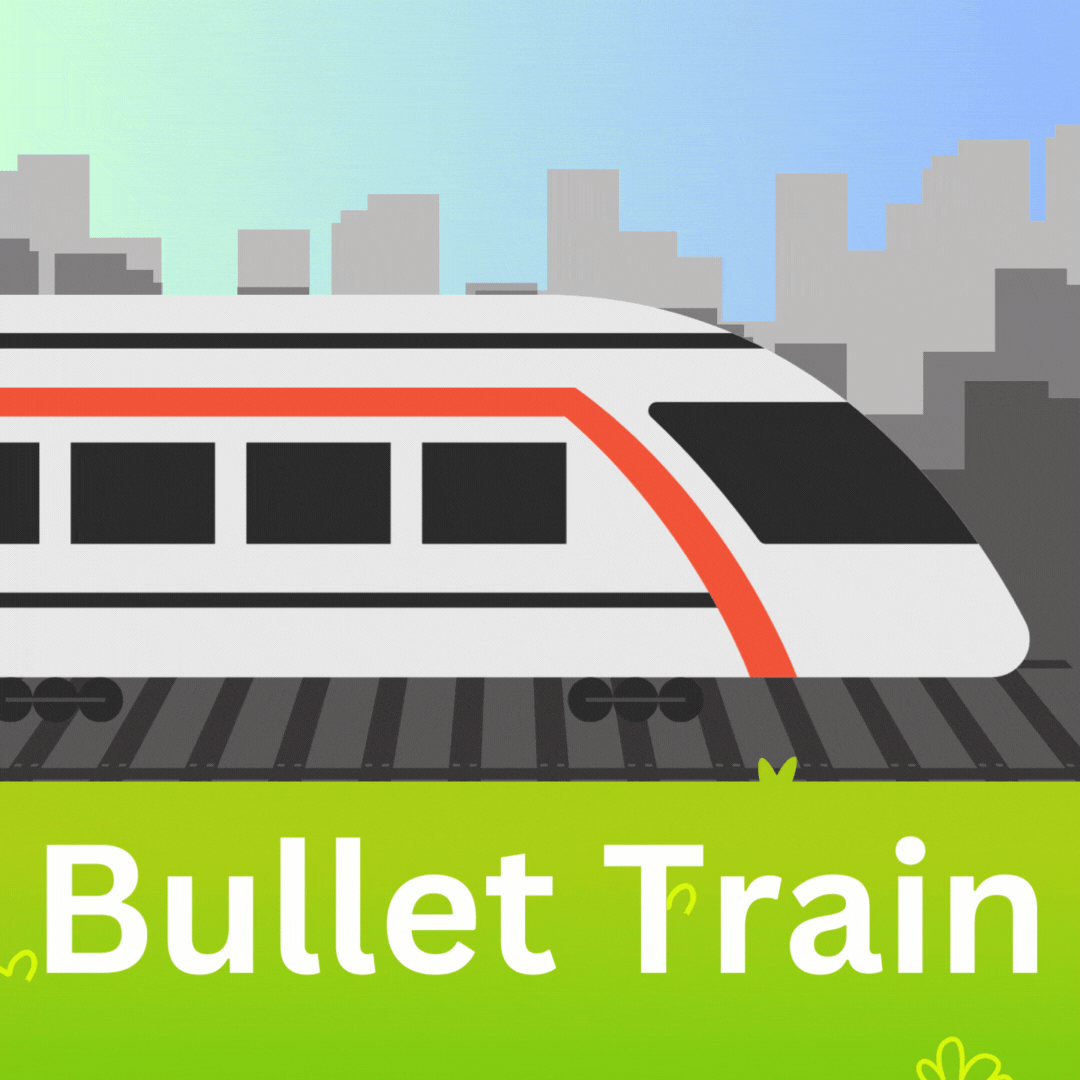
Travel by shinkansen (bullet train)
It is probably one of the most comfortable and quickest ways to get around Japan, but it can get expensive quickly! Make sure to check out the travel passes mentioned above to see if you can find discounts for tourists. If you are a long-term resident, there are also passes available, but they are very expensive and many people have this expense covered by their workplace when necessary.
Shinkansen tickets are special, and you can purchase them at a machine or in person.
Useful Japanese for travel by shinkansen
Japanese for travel by shinkansen (bullet train):
- Buying Shinkansen Tickets (When visiting the in-person ticket purchase counter):
- English: “Excuse me, I’d like to buy a shinkansen ticket to [destination].”
- Japanese: すみません、[目的地] 行きの新幹線の切符を買いたいのですが。 (Sumimasen, [mokuteki] yuki no shinkansen no kippu wo kaitai no desu ga.)
- Asking for Platform Information:
- English: “Excuse me, which platform is the shinkansen to [destination]?”
- Japanese: すみません、[目的地] 行きの新幹線のホームはどこですか? (Sumimasen, [mokuteki] yuki no shinkansen no hoomu wa doko desu ka?)
- Boarding the Shinkansen:
- English: “Excuse me, is this the platform for the shinkansen to [destination]?”
- Japanese: すみません、こちらは[目的地] 行きの新幹線のホームですか? (Sumimasen, kochira wa [mokuteki] yuki no shinkansen no hoomu desu ka?)
- Inside the Shinkansen:
- English: “Excuse me, is this seat reserved?”
- Japanese: すみません、この席は予約されていますか? (Sumimasen, kono seki wa yoyaku sareteimasu ka?)
- English: “Excuse me, how long does it take to get to [destination]?”
- Japanese: すみません、[目的地] までどのくらいかかりますか? (Sumimasen, [mokuteki] made dono kurai kakarimasu ka?)
- Exiting the Shinkansen:
- English: “Excuse me, is this the station for [destination]?”
- Japanese: すみません、ここは[目的地] の駅ですか? (Sumimasen, koko wa [mokuteki] no eki desu ka?)
- General Phrases you may hear in the station:
- English: “Please be mindful of the quiet car.”
- Japanese: 静かな車両にご配慮ください。 (Shizuka na sharyou ni go hairyo kudasai.)
- English: “Please refrain from talking on your mobile phone.”
- Japanese: 携帯電話での通話はお控えください。 (Keitai denwa de no tsuwa wa okotowari kudasai.)
Types of shinkansen
There are many shinkansen (bullet trains) available to ride. Here is a list of the trains. They vary in age, speed, comfort, and destination.
- Nozomi: Fastest, makes few stops, mainly on the Tokaido and Sanyo lines.
- Hikari: Slower than Nozomi, but still fast, with more stops.
- Kodama: Slower than Hikari, makes many stops, good for shorter distances.
- Hayabusa, Hayate, Yamabiko: These are on the Tohoku Shinkansen line, with Hayabusa being the fastest.
- Mizuho, Sakura: These run on the Sanyo line to Kyushu, with Mizuho being faster.
- Toki, Tanigawa, Max Tanigawa: Joetsu Shinkansen, with Toki being the fastest.
- Kagayaki, Hakutaka, Asama: Hokuriku Shinkansen, with Kagayaki being the fastest.
Types of shinkansen tickets
Yes, there are even multiple types of tickets available for the shinkansen. Avoid overpaying or stress by choosing the right one! The boarding area for each ticket is different. Pay attention to what ticket you buy and where the boarding location is located. Always know you can ask for help!
The base fare ticket and add-ons
Base Fare Ticket (乗車券 – じょうしゃけん, joushaken)– This ticket covers the base fare for your journey based on the distance between your departure and destination stations. It allows you to board the train. You will always get this, and if you choose to reserve a special car,seat, or ride limited express, you will end up with two tickets.
Green Car Ticket (グリーン券 – ぐりーんけん, guriinken): If you choose to travel in the Green Car, which is a more luxurious class with wider seats and more legroom, you will need a Green Car Ticket in addition to your Base Fare Ticket.
Limited Express Ticket (特急券 – とっきゅうけん, tokkyuuken): If you are traveling on a limited express service, such as the Nozomi or Mizuho Shinkansen trains, you may need a Limited Express Ticket in addition to your Base Fare Ticket.
Ticket types
普通券 (ふつうけん – futsuken): This is a regular, one-way ticket for a specific journey.
回数券 (かいすうけん – kaisuken): This is a discount ticket for multiple journeys between the same two stations.
指定席券 (していせきけん – shiteisekiken): This is a reserved seat ticket, where you can choose your seat in advance. Often, there is very limited space to sit on the shinkansen. If you aren’t comfortable standing, it’s best to reserve a seat.
自由席券 (じゆうせきけん – jiyuusekiken): This is an unreserved seat ticket, where you can sit in any available seat in the non-reserved car.
グリーン券 (ぐりーんけん – guriinken): This is a ticket for the Green Car, which is a more luxurious class with wider seats and more legroom. Personally, I have never used it and don’t think it is worth it…
Transportation by subway
The subway is one of my favorite ways to travel because it is super convenient and the stations are usually full of fun shopping and dining opportunities. However, you won’t get a nice view from your window. The subways are way more straightforward than trains, but make sure you are getting the right ticket or are going to the correct line!
Using an IC card makes it super simple!

Useful Japanese in the subway station
- English: “Excuse me, where is the subway?”
- Japanese: すみません、地下鉄はどこですか?(Sumimasen, chikatetsu wa doko desu ka?)
- English: “Which line goes to [destination]?”
- Japanese: [目的地] 行きはどの線ですか?([Mokuteki] yuki wa dono sen desu ka?)
- English: “How much is the fare to [destination]?”
- Japanese: [目的地] までの運賃はいくらですか?([Mokuteki] made no unchin wa ikura desu ka?)
- English: “Is this the right platform for the train to [destination]?”
- Japanese: ここは[目的地] 行きのホームですか?(Koko wa [mokuteki] yuki no hoomu desu ka?)
- English: “How many stops to [destination]?”
- Japanese: [目的地] まで何駅ですか?([Mokuteki] made nan-eki desu ka?)
- English: “Excuse me, is this seat taken?”
- Japanese: すみません、この席は空いていますか?(Sumimasen, kono seki wa aiteimasu ka?)
- English: “Excuse me, which exit should I take for [destination]?”
- Japanese: [目的地] にはどの出口を使えばいいですか?([Mokuteki] niwa dono deguchi wo tsukaeba ii desu ka?)
- English: “Where is the ticket gate?”
- Japanese: 改札口はどこですか?(Kaisatsuguchi wa doko desu ka?)
- English: “Please give me a map of the subway.”
- Japanese: 地下鉄の地図をください。(Chikatetsu no chizu wo kudasai.)
- English: “Is there a restroom in the station?”
- Japanese: 駅にはトイレがありますか?(Eki niwa toire ga arimasu ka?)
The many lines of the subway station
Good news! Subway travel is much simpler than others. Each subway has a line that goes back and forth. Just make sure you pick the right line!
- Tokyo: There are two main subway operators in Tokyo, Tokyo Metro and Toei Subway. They have 13 lines that cover the city and nearby areas.
- Osaka: Osaka Metro operates eight subway lines that are color-coded and numbered. They help people travel around Osaka and nearby areas.
- Kyoto: Kyoto has two subway lines, the Karasuma Line and the Tozai Line, which connect the city center with popular attractions.
- Nagoya: Nagoya has six subway lines that cover the city and connect with other transportation options.
- Fukuoka: Fukuoka has three subway lines that provide transportation within the city and to the airport.
Transportation by trains, shinkansen, and subway links!
Top 3 travel cards
These are the most commonly accepted IC cards in Japan. Some have apps if you are interested. Here are their English websites.
https://www.jreast.co.jp/multi/pass/suica.html
https://www.pasmo.co.jp/visitors/en/
https://www.westjr.co.jp/global/en/howto/icoca/
Special opportunities for tourists and short-term stays
Depending on your location, you can get special deals and discounts when you travel. This is only for tourists and short-term stays. Sorry, my fellow long-term residents, no discounts or cute cards for us…
https://www.westjr.co.jp/global/en/ticket/
https://www.jreast.travel/jreastpass/
Travel with Rakuten!
Rakuten travel is a good way to get around. Click the banner below or the link here to get started!





Comment